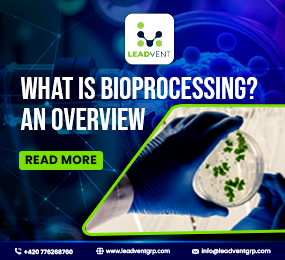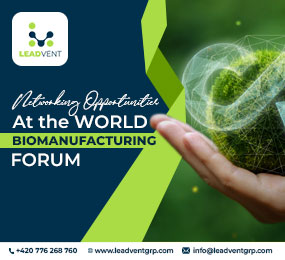The frequent climate changes and environmental degradation have a detrimental impact on every industrial sphere and it is also necessitating the industries to rethink and reconsider their procedure of work. Bioprocessing has emerged as a beacon of hope to the entire pharmaceutical industry and it is steering this industry towards a sustainable direction so that productivity gets enhanced without affecting nature.
World Biomanufacturing Forum, 2024 is a promising endeavour to delve deeper into the biomanufacturing process to foster innovation via insightful discussion. This premier global event is preparing industry leaders and policymakers to come up with new-age breakthroughs that leave no detrimental impact on nature. The interactive panel of discussion is going to include a range of aspects in the sphere of bioprocessing, ranging from personalised medicine to the new trends and innovations in the sphere of bioprocessing. Here in this blog, we are going to underscore the sustainable innovations in the pharmaceutical sphere that may reshape the whole industry in a new light with the assistance of a biomanufacturing conference.
What is Bioprocessing?
In simple words, bioprocessing is a method of using microorganisms and enzymes for the production of life-saving medicines without affecting the natural ecosystem. The production of medicines or drugs in reality generates significant waste and also ends up in a high amount of emission at the same time. Deviating from the traditional approach, bioprocessing takes part in the utilization of renewable resources, reduction of emissions, and conversion of biomass into valuable products like biofuels, bioplastics, and pharmaceuticals.
Innovations in Bioprocessing
The bioprocessing industry is at the forefront of sustainable manufacturing, capitalising on advanced technologies to reduce the environmental impact while meeting the growing demand for eco-friendly products. Here are the innovations that are reshaping the process of bioprocessing and enabling the industry to incline towards more eco-friendly practices.
Waste Biomass Utilization
Nowadays the innovative approach of bioprocessing is helping in the reduction of the pollution rate by offering an alternative path of generating chemicals and bio-based energy components. This approach in reality is all about the transformation of the waste into valuable resources.
Renewable Energy Integration
The integration of renewable energy sources into biomanufacturing processes is becoming significant. As the entire globe is shifting to solar, wind, or other renewable sources for energy needs, organisations are indulging in the activities of reducing their carbon footprints and contributing to a safe and sound planet for all.
Single-Use Technologies
Single-use technologies have appeared as a critical innovation in the sphere of bioprocessing. These systems take part in the reduction of water consumption and energy usage in comparison to traditional stainless-steel equipment.
Life Cycle Assessment
Life cycle assessment is another notable approach in the sphere of bioprocessing that takes part in the careful evaluation of the entire lifecycle of products from extraction of the raw materials to end-of-life disposal.
Environmental Benefits of Bioprocessing
Sustainable manufacturing is no longer an alternative, rather it has turned into an essential aspect as the entire world is striving to wage war against climate change and depletion of resources. Here are some of the major environmental benefits of bioprocessing that must be taken into account for a greener planet.
Low Rate of Waste Generation
One of the most notable advantages of bioprocessing is its ability to produce less amount of waste in comparison to the traditional method. Plus, this innovative approach relies on renewable resources to generate the by-products out of them that are repurposable.
Biodegradable Products
The products generated through bioprocessing are most of the time found to be biodegradable, reducing the environmental impact of waste disposal. Bioplastics, for instance, are made from renewable resources like cornstarch or sugarcane and can break down naturally.
Low Energy Consumption
Energy scarcity all over the globe is a pressing challenge and it is posing difficulties in the trajectory of seamless business operation. This technique acts under mild conditions and that's why it saves a huge amount of energy which is hardly possible in the traditional manufacturing process.
Case Studies
Case study of Keck Graduate Institute
At Keck Graduate Institute, the students of the PhD programme are tackling real-world challenges strategically with the usage of bioprocessing techniques. In the course of the research, the students are taking part in the exploration of the usage of analytical tech solutions for addressing major societal problems.
FAQs
1) What is sustainable manufacturing?
Sustainable biomanufacturing refers to a process of using biological procedures to produce goods and minimising the carbon footprints on nature.
2) How does sustainable biomanufacturing contribute to a circular economy?
Through waste reduction, utilisation of renewable resources and recycling of materials, sustainable biomanufacturing can contribute to the circular economy.
3) What future trends can we expect in sustainable biomanufacturing?
In future, it is expected that integration with AI will result in process optimisation and more emphasis on green chemistry.
Final Words
Innovations in bioprocessing are a call for a new future and at the same time, it is inviting people all across the world to participate in thought-provoking discussion sessions for generating more such creative ideas. As the demand for sustainable products continues to grow, it is expected that in future it will be crucial for ascertaining long-term success. To become a significant part of the bioprocessing revolution and join World Biomanufacturing Forum, 2024, the grand biomanufacturing conference, connect with our Leadvent Group now.














